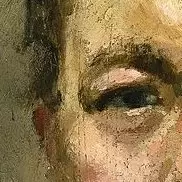This painting is one of the first representations of urban proletariat. Whereas peasants (Gleaners by Millet) or country workers (Stone Breakers by Courbet) had often been shown, city workers had seldom been painted. Unlike Courbet or Millet, Caillebotte does not incorporate any social, moralising or political message in his work. His thorough documentary study (gestures, tools, accessories) justifies his position among the most accomplished realists.
Caillebotte had undergone a completely academic training, studying with Bonnat. The perspective, accentuated by the high angle shot and the alignment of floorboards complies with tradition. The artist drew one by one all the parts of his painting, according to the academic method, before reporting them using the square method on the canvas. The nude torsos of the planers are those of heroes of Antiquity, it would be unimaginable for Parisian workers of those times. But far from closeting himself in academic exercises, Caillebotte exploited their rigour in order to explore the contemporary universe in a completely new way.
Caillebotte presented his painting at the 1875 Salon. The Jury, no doubt shocked by its crude realism, rejected it (some critics talked of “vulgar subject matter”). The young painter then decided to join the impressionists and presented his painting at the second exhibition of the group in 1876, where Degas exhibited his first Ironers. Critics were struck by this great modern tableau, Zola, in particular, although he condemned this “painting that is so accurate that it makes it bourgeois”.
https://www.musee-orsay.fr/en/artworks/raboteurs-de-parquet-105
My back and knees hurt just looking at this picture.
That’s one of the great things about the impressionists - they showed common people just living their lives. That is something that hadn’t really been seen before that time. The subject was always some duke or christ up until then.
Welcome to my life. Kneepads help.
Thank fuck I don’t have to use a (manual) plainer for this task in today’s age.
Not really related to the painting but I got to say this is a really interesting lemmy community, glad to have found it.
That’s one hell of a “small apartment.”
Right, it’s probably quite large to many people.
The site was in French, and while the title was “Raboteurs de parquet,” I took the liberty of giving the translation my best effort since Parquet is a word in both French and English. In English it means a design on a floor made with wood. It can also mean a small space. And it seemed like in French it was kinda both of those things (even though they’re not making a design, so I probably misunderstood something along the way). I think the title is more of a pun than I was able to convey. Of course, I could’ve just left it as Parquet, but I wanted it to be accessible to everyone and not require knowledge of such an obscure word.
Anyway, all that is to say: You have every right to be jealous of the size of the apartment with how bad things are for everyone right now - and back in 1875 this “small” apartment was probably much cheaper than it would be today. But no offense was intended, and the artist - while being bourgeois elite, only meant to show the lives of the working class - a common trait among impressionists, expressionists and generally art of the industrial revolution.
I’ve had the chance to see this painting in real life at Musée d’Orsay and it’s one of the most impressive and stunning painting I’ve seen. It’s beautiful, and so is the museum.
This synopsis is too wordy for my pea brain. Is it stating that workers would not be shirtless in ~1875 Paris as it would be considered too risqué?
I’m thinking it means workers of that time would not have that physique.
Oh wow I hadn’t seen this in ages.
My parents had a reprint hung on a wall in our old house.This is such an unexpected nostalgia trip.
I would like to subscribe to pro-labor art facts, please.
Thanks for the detailed write up!




